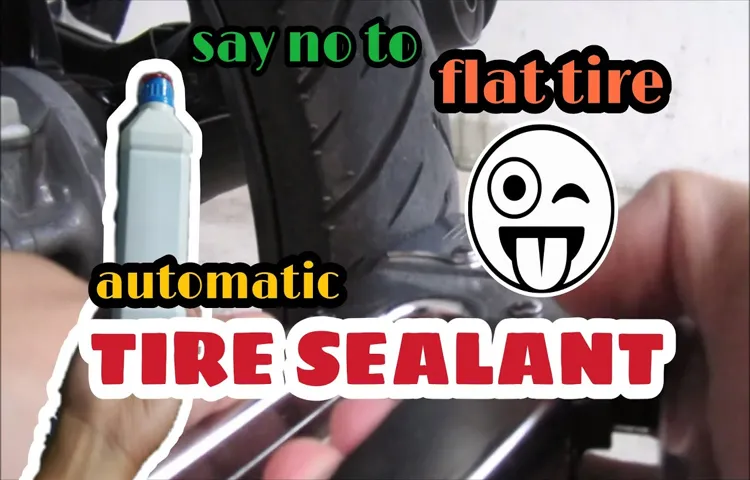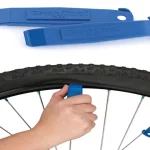Tire sealant is a must-have item for any car owner. It’s easy to use and it can save you from the stress and expense of a flat tire. However, many people wonder how long it takes for the sealant to dry.
The drying time of tire sealant depends on several factors, and it’s crucial that you understand these factors to use the sealant effectively. In this blog, we’ll answer all your questions and give you some tips to make the most out of your tire sealant. So buckle up and let’s dive in!
Table of Contents
Understanding Tire Sealant
If you’re thinking about using tire sealant, one important thing to consider is how long it takes to dry. The answer to this question can vary depending on the brand and the specific product you’re using, but most tire sealants take anywhere from 15 minutes to a few hours to fully dry. It’s important to note, however, that drying time isn’t the same as curing time.
While the sealant may be dry to the touch after 15 minutes or so, it may take several hours or even a full day for it to fully cure and create a strong, permanent seal. If you’re in a hurry, look for fast-drying sealants that will dry more quickly, but be sure to read the instructions carefully to ensure you’re using the product correctly and giving it enough time to cure before driving on it. Overall, tire sealant can be a great way to quickly and easily fix a flat tire, as long as you take the time to understand how it works and use it correctly.
What Is Tire Sealant?
Tire sealant is a liquid-filled substance designed to seal punctures and leaks in tires, providing a quick and temporary repair solution. It works by filling the gap created by the puncture and forming a seal to prevent air from escaping the tire. The substance is typically made from a blend of latex, fibers, and other synthetic materials that bond with the tire rubber to create a flexible and durable seal.
Tire sealant is easy to use and is commonly available in cans or bottles that can be easily stored in a vehicle’s trunk or tool kit. This solution is ideal for emergency situations and can be used on various types of tires, including cars, motorcycles, and bicycles. However, it is important to note that tire sealant is only a temporary fix and should be replaced with a permanent repair solution as soon as possible.

How Does Tire Sealant Work?
Tire sealant is a material commonly used to repair punctured tires without having to replace them altogether. This clever solution works by injecting a sealant into the tire, which then coats the inside of the tire and seals any punctures. The sealant itself is a viscous liquid that typically contains fibers, polymers, and other binders that help it adhere to the tire’s inner surface.
Once the sealant is injected, it can easily flow to wherever the puncture is and quickly fill any gaps, preventing any loss of air pressure. Many tire sealants even include a compressor that inflates the tire to its proper pressure, making the repair process painless. It’s a quick and easy fix for a vehicle owner and can save a trip to the tire store or the need for a tire replacement.
So, next time you’re driving on the road and get a flat tire, consider using tire sealant before shelling out for a new tire.
Factors Affecting Drying Time
If you’ve recently used tire sealant, you may be wondering how long it takes to dry. The answer is that it depends on several factors. Firstly, the type of sealant used can affect drying time; some sealants dry faster than others.
Additionally, the amount of sealant used and the temperature and humidity of the environment can play a role in drying time. In general, sealant can take anywhere from a few minutes to several hours to fully dry, so it’s best to consult the product instructions for specific details. Keep in mind that even after the sealant is dry, it may take some time for the tire to fully inflate and for any leaks to fully seal.
And if you’re using sealant as a temporary fix until you can get a tire repaired or replaced, it’s important to remember that it’s not a long-term solution. So if you want to ensure the safety of your tires and vehicle, make sure to address any underlying issues promptly.
Type of Tire Sealant
When it comes to tire sealant, there are different types available in the market. These sealants vary based on their formulation and the type of vehicle they are meant for. However, one common factor that affects all types of tire sealants is their drying time.
The drying time of a tire sealant can be influenced by several factors, including the temperature, humidity, and the amount of sealant used. Generally, the higher the temperature and humidity, the faster the sealant will dry, and the lesser amount of sealant used, the faster it will dry. But, using too little sealant can also compromise its effectiveness.
Similarly, high humidity can lead to a thicker and slower drying sealant. Therefore, it is crucial to use the right amount of sealant and to consider the prevailing weather conditions when applying it. Understanding the factors that affect the drying time of a tire sealant can help vehicle owners make informed choices about the type of sealant they use and how they use it to get the best results.
Amount of Tire Sealant Used
When it comes to the amount of tire sealant used, there are a few factors that can affect the drying time. One of the main factors is the temperature. If the temperature is too cold, the sealant will take longer to dry.
On the other hand, if it’s too hot, the sealant can dry too quickly and cause clumps to form. Another factor to consider is the type of sealant used. Different sealants have varying composition and can affect the drying time.
It’s essential to use the recommended type and amount of sealant to ensure optimal results. Additionally, the amount of sealant used can also affect the drying time. If too little is used, it may not provide enough coverage, while using too much can lead to extended drying time.
Overall, it’s essential to find the right balance between amount and type of sealant used while considering factors such as temperature to achieve the best results.
Temperature and Humidity
Temperature and Humidity are two of the most important factors that affect drying time. The temperature in the area where the drying is taking place can have a big impact on how quickly the material being dried will lose moisture. In general, higher temperatures will cause water molecules to evaporate more quickly, leading to faster drying times.
Humidity also plays a significant role in drying time. If the relative humidity in the drying area is high, it can slow down the drying process because there is already a lot of moisture in the air that needs to be removed before the material itself can dry. Conversely, if the relative humidity is low, the drying process will be faster because the air is more readily able to absorb moisture from the material being dried.
It’s important to carefully monitor temperature and humidity levels during the drying process to ensure that the material dries consistently and without issue.
Drying Time for Different Tire Sealants
If you’re wondering how long tire sealant takes to dry, the answer varies depending on the type of sealant you use. Generally, most sealants take about 10-15 minutes to dry before they can start sealing punctures. However, some high-end sealants can dry in as little as 1-2 minutes.
It’s important to read the manufacturer’s instructions carefully and follow their guidelines for optimal results. Additionally, factors such as temperature and humidity can affect drying times, so it’s best to apply sealant in a dry, warm environment for the quickest results. Ultimately, investing in a quality tire sealant can save you time and hassle by preventing flats and leaks from ruining your ride.
So, if you’re planning to hit the trails or go on a long road trip, be sure to arm your tires with the right sealant and give it enough time to dry before you hit the road.
Latex-based Tire Sealants
Latex-based tire sealants have been a popular choice among cyclists, motorists and off-roaders for several reasons. For instance, they are made up of natural rubber latex mixed with different additives that prevent the tire from getting punctured. Nonetheless, the drying time for each sealant varies, with some drying in a couple of minutes and others requiring a longer time.
Factors such as the weather, temperature, and amount of sealant applied can influence the drying time. Some sealants, like Stan’s NoTubes, can dry within minutes while others like the Effetto Mariposa Caffelatex takes about 45 minutes. If you’re in a hurry, opt for a sealant like Finish Line Premium that dries in around 10 minutes.
When selecting the appropriate tire sealant, it’s crucial to consider factors like drying time, effectiveness, and the number of punctures it can seal. Ultimately, the drying time plays a vital role in determining how long the repair will last before getting back on the road or trail.
Fiber-based Tire Sealants
Fiber-based tire sealants are a popular choice among many drivers due to their effectiveness at sealing punctures and their ability to provide a smooth ride. However, one factor to consider when choosing a fiber-based sealant is the drying time. Different sealants vary in their drying time, which can range from a few minutes to several hours.
This can impact how quickly you can get back on the road after a flat tire. Some sealants, such as those containing latex, typically dry faster than those made from natural fibers. However, it’s important to note that the drying time can also be influenced by other factors, such as temperature and humidity.
Regardless of the drying time, it’s always a good idea to check your tire pressure after using a fiber-based sealant to ensure that it is at the correct level. Overall, fiber-based sealants offer a reliable and convenient solution for dealing with punctures on the road.
Chemical-based Tire Sealants
Chemical-based tire sealants are among the most common types of sealants used to repair punctured tires. These sealants work by creating a chemical reaction that fills the hole in the tire and seals it shut. The drying time for chemical-based tire sealants can vary depending on several factors, including the brand and type of sealant used, the size of the puncture, and the temperature and humidity of the surrounding environment.
Generally, most chemical-based tire sealants dry within 5-10 minutes after application. However, some sealants can take longer to dry, especially if the puncture is large or the conditions are particularly humid. It is important to note that using a tire sealant does not mean you should forego a proper tire repair.
In most cases, a mechanic should inspect and repair the tire properly to ensure longevity and proper safety.
Conclusion
In the world of tire sealant, patience is key. Like a fine wine or a certain blockbuster sequel, tire sealant takes time to reach its full potential. The drying time can vary depending on the brand and the severity of the puncture, but one thing is certain: if you rush the process, you’re likely to end up with a sticky mess that won’t provide the long-lasting protection you need.
So instead of watching the clock tick by, try distracting yourself with a good book, a cup of tea, or a lively game of Pictionary. And before you know it, your tire will be ready to hit the road once again. Happy driving!”
FAQs
What is tire sealant and how does it work?
Tire sealant is a liquid substance that is designed to seal punctures and leaks in tires. It coats the tire’s inner surface and dries to form a seal around punctures, preventing air from leaking out.
Can tire sealant repair larger punctures?
Most tire sealants are effective at repairing small punctures, up to around 1/4 inch in diameter. Larger punctures may require a professional repair or replacement of the tire.
How long does it take for tire sealant to dry?
This can vary depending on the brand of tire sealant and the temperature and humidity of the environment. In general, most tire sealants take anywhere from a few minutes to a few hours to dry completely.
How long can tire sealant repair a puncture?
Tire sealant is designed to be a temporary repair, typically lasting for around 100 miles of driving or until the tire can be professionally repaired or replaced.
Can tire sealant harm TPMS sensors?
Most tire sealants are safe for use with TPMS (tire pressure monitoring system) sensors. However, it is important to read the instructions and choose a sealant that is specifically labeled as safe for use with these sensors.
Is tire sealant a permanent fix for punctures?
No, tire sealant is not a permanent fix for punctures. It is a temporary solution that is meant to get you to a repair facility or home safely.
Can tire sealant be used on all types of tires?
Most tire sealants are compatible with all types of tires, including tubeless and tube-type tires. However, it is important to check the instructions and ensure that the sealant is suitable for your specific type and size of tire.



